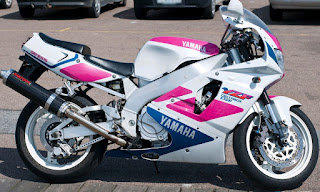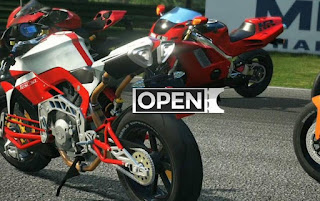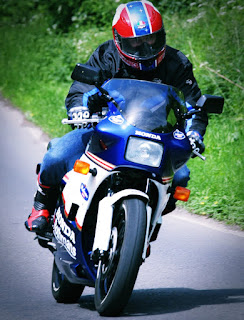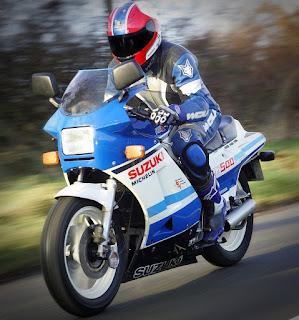Stylish and with amazing street presence : The Kawasaki S1A.
Whatever else you may say about Kawasaki’s earlier Inline triples, even the most curmudgeonly, misanthropic philistine would be hard-pushed to say the bikes don’t have style and street presence. The asymmetric exhaust is there to get noticed - imbalance is good for getting a response.
Kawasaki S1A : Styling
Every manufacturer of the period used candy paint and vinyl graphics but few did it so well and the look and lines are like no other. And no one, but no one else had the bare-faced cheek or courage to put a tail piece on a 250cc Japanese motorcycle. Even the H1s had a bare derrière until 1973. The S1 series had one singular purpose for existence and that was to get youngsters on board Kawasakis. It’s probably fair to say that the S1 range sold to learners who favoured form over function.
The bike sold more on looks than anything else. If you’d managed to coerce mum and dad to sign as guarantors on the HP agreement you’d done so because the bike looked so uber-sexy sitting in the dealer’s window.
Very little looks like a Kawasaki S1, which was obviously the intention of the stylists. There’s an almost aggressive stance to the bike and from any angle it looks ready for action. The layout of the iconic exhaust system is there for effect, with two silencers on the right and one on the left. Have a look at the centre pot’s exit route. It is little short of a work of art how it manages to find its way out and even better how it contrives to run parallel to its neighbour – stunning stuff.
Looking up from the exhaust system there’s a decent-sized dual seat that’s very obviously intended to take a passenger. We’re firmly in the 1970s here and motorcycles still have to be able to multitask, commuting Monday to Friday, a bit of manic one-up as and when but not forgetting to pick up the girlfriend on Saturday evening. Unique to the 250 of the period is the famous Kawasaki seat hump. Even if there’s precious little room inside it still looks special. In the increasingly competitive learner market of the early 70s such things were important.
Moving forward there’s a fairly long tank aiding the impression that the bike is bigger than it is. This and the aforementioned saddle somehow combine to give an illusion of greater size. This is more marketing spin to get buy-in from the kids of the day and something Honda would latterly emulate with their Superdreams.
Across the top yoke is a pair of clocks unlike anything the opposition are using. They have a unique look to them that’s both clinically clean yet funky at the same time, almost military in style. With the parent company making planes and helicopters it makes you wonder if the look was drawn up in-house before being handed over to Nippon Seiki or whoever.
Out on the ends of the bars there is a set of tactile grips that suggest you’ll need their assistance to hold on, some companywide switchgear and a curious little lever just inboard of the throttle. Hang on what’s that doing there? This is another early triple foible and possibly another ploy to distinguish the factory’s products from its rivals. Yes, defying logic, perceived wisdom and possibly common sense as well it’s the choke lever. Even better it is spring-loaded and rotates in the same direction as the twist grip, which should make starting fun.
Up front it’s all standard fare with a pair of exposed fork stanchions and a drum brake running a twin-leading shoe arrangement. When launched at the tail end of 1971, both the S1 and S2 ran the same twin-leading shoes front brake but for the A series models of the 1973 model year the S2 received a disc brake. The 250 was considered to be sufficiently well braked that the drum would remain in place right to the end of the S1’s life. But what’s it like to ride ?
Kawasaki S1A Ride Test !
Fuel on, turn the ignition key and pull out the kick-start lever, which feels like no other I’ve ever used. It’s long, it’s high and it sticks out at a jaunty angle. Initially a little confusing, the layout is a little more logical when you consider the need for the starting mechanism to miss that stunning duo of pipes on the right-hand side.
Having regained my balance and adjusted to the lever arrangement it’s time to grasp the throttle and choke set up. With a positive stop choke lever on the carburettors like Yamaha or Suzuki you don’t give the fuel enrichment system a second thought, but on the S1A you need to hold the choke down with your thumb, kick through and hopefully catch the motor as it fires.
Thankfully, I’m able to let the choke off almost instantly and, with a little judicious throttle tweaking, the tiny triple soon gets some warmth into it. Ensuring there’s sufficient heat in the motor is never a chore. There’s a perpetual mechanical clattery rustle from the motor that somehow seems to convey a sense of impeding urgency. The airbox has only rudimentary baffling as it inhales deeply and finally there’s that trio of silencers.
Make no mistake, they are tuned not only for performance but tone as well. Racer on the road wouldn’t be an over exaggeration as they really do sound that good and further egg the rider on to give the throttle just one more twist. In a nutshell it sounds delicious.
Throwing a leg over the seat and getting myself sorted out the first thing that’s apparent is the rise of the handlebars, but then again this is a USA market machine and owner Chris decided to keep it as authentic and original as possible. For a Stateside machine the bars are nowhere near as raised as some I’ve sampled and as it’s a 250 I’m riding I doubt they’ll provoke an unintended wheelie unless I am totally stupid.
Settling onto the comfortable seat it’s time to see what the teenage tearaway is capable of. Initially the experience is less than inspiring but that’s more a criticism of the rider than the bike. At first the pick-up seems almost flat and uninspiring, but after a very brief period of acclimatisation it’s very obviously apparent that the bike wants some revs. Three small pots on a 250 are never going to provide the low down torque of an RD250 or the solidity of a CB250. The bike was designed to be a Banzai, brain out, bolide and not a good all-rounder.
So with recalibrated expectations and inputs let’s try that again shall we? Open the taps, slip the clutch and away hurtles the Candy Gold S1A. The change from first to second gear is a little ropey but apparently many are like that. Even the smallest amount of wear on an S-series gear pedal linkage can have a profound and adverse effect. With just a little practice I have it sussed and then we can start to rock ‘n’ roll.
If aesthetics and bragging rights were the primary reasons for kids back in the day buying an S1 then it was surely the noise and sensations that ensured the bike didn’t get swapped for something more sensible The sound of an S1 coming on pipe and hitting that sweet spot is seriously like nothing else. The screaming wail of the three pipes is beguiling and addictive. Factor in the rasping drone of the inlet system as it gets a proper workout and the auditory input is almost hypnotic.
Everything comes together when the tacho needle begins to nudge 5500 rpm and then slips towards 6000. The whole thing comes alive, with pipes and porting gel as one and the bike sears forwards. Keep the smallest stroker triple here or hereabouts and you’ll be smiling like a loon dancing on the gear pedal and playing tunes all day.
The same feral edge of the legendary H1 seems to have been condensed and planted somewhere with the S1. This is truly a bike that could and would generate brand loyalty.
It’d be easy to think that the S1 is all about its power unit and to a degree you’d be correct. After all this was the bike’s unique selling point back in the day. However, even Kawasaki knew that the 250 couldn’t emulate its famous 500 in terms of handling.
The S1 handles much better than its big brother and so it should. Surprisingly light and predictable for a bike that’s wider than most of its ilk, it tracked around perfectly for our riding shots and was even happy to undertake feet-up 180s at walking pace. At speed the little triple never seemed anything other than sure-footed and was blissfully happy to change line if asked.
Suspension was no better than a comparable Yamaha twin of the period but measurably superior to a Honda CB250 K Series. In terms of braking some criticise the continued use of the twin-leading shoe front brake in the light of the S2A being equipped with a disc. Having ridden with both types of front anchor on smaller triples, my money is on the S1A’s drum brake. Powerful, progressive and not especially prone to fade after a series of action shots and the inevitable turn-arounds, it impressed all day long.
Back in the day some elements of the press suggested that S1/KH250 owners only had six brain cells, which was purportedly all they needed to ride the smallest of the genre. I’d counter that facetious statement by saying those same critics only used six brain cells to reach their myopic conclusion.
Yes, the bike majors on frenetic performance, I agree it emits an unholy sound and without doubt it can egg you on to misbehave, but that’s just one aspect of its character. The super-smooth engine, the style, the looks and, surprisingly, the comfort, are aspects of ownership the bike’s detractors chose to ignore.
I’d go so far as to say that the S1 Kawasaki is probably THE iconic learner of the period. It has it all - performance, looks and fun factor. If I go on record as saying that I could find space for one in my garage, does that convey just how good these bikes are?
Kawasaki S1A Specifications
Manufacturer : Kawasaki
Model: S1A 250
Year Built : 1972 - 1975
Engine: 2-Stroke, Inline-Triple (3-Cylinder), Piston-Port, Air Cooled
Bore x Stroke : 45 x 53.2 mm
Displacement : 249 cc
Compression ratio : 7.5: 1
Fuel Supply : 3 x Carburetor Mikuni VM22SC
Ignition : Coil
Starter system : Kick-Starter
Transmission : 5-Speed
Max Power : 32 HP @ 8.500 RPM
Max Torque : 25 N.m @ 7.000 RPM
Dimensions L x W x H : 2.019 x 820 x 1.035 mm
Wheelbase : 1.371 mm
Seat height : 800 mm
Dry weight : 149.5 Kg
Fuel tank capacity : 15 Liter
Frame: Tubular-Steel Double Cradle
Suspension Front: 34mm Telescopic Fork
Rear Suspension: Dual Kawasaki Shockbreaker
Brakes Front: 180mm Drum Brake
Rear brakes: 180mm Drum Brake
Front tires: 3.00 - 18 Inch
Rear tires: 3:25 - 18 Inch


































